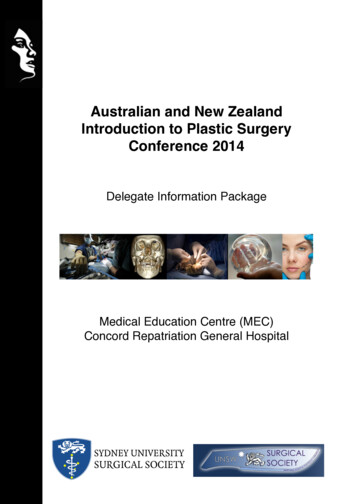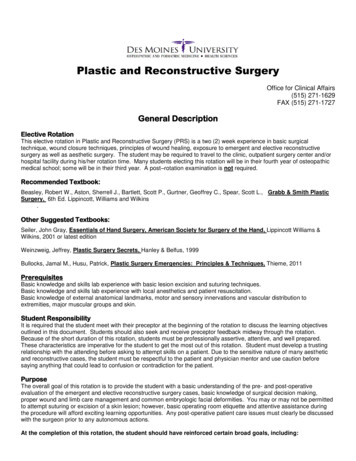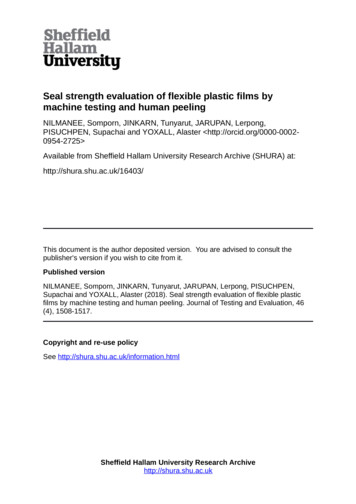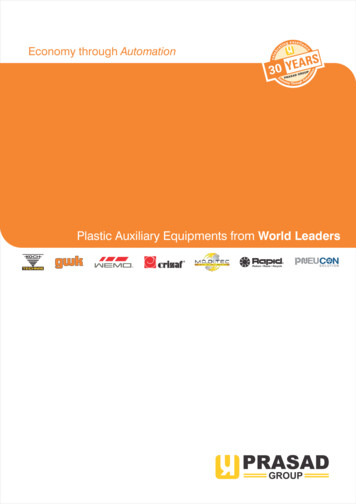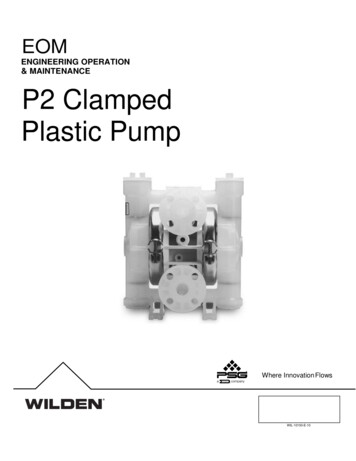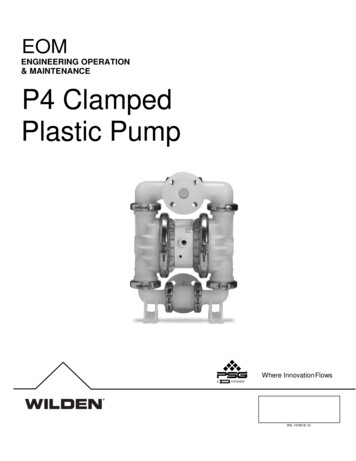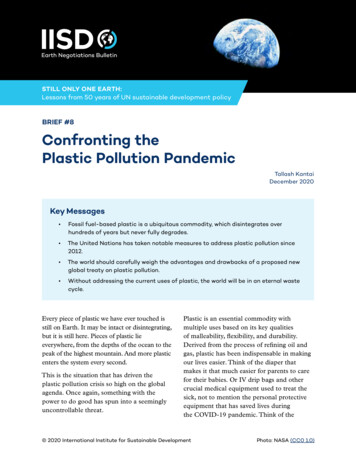
Transcription
STILL ONLY ONE EARTH:Lessons from 50 years of UN sustainable development policyBRIEF #8Confronting thePlastic Pollution PandemicTallash KantaiDecember 2020Key Messages Fossil fuel-based plastic is a ubiquitous commodity, which disintegrates overhundreds of years but never fully degrades. The United Nations has taken notable measures to address plastic pollution since2012. The world should carefully weigh the advantages and drawbacks of a proposed newglobal treaty on plastic pollution. Without addressing the current uses of plastic, the world will be in an eternal wastecycle.Every piece of plastic we have ever touched isstill on Earth. It may be intact or disintegrating,but it is still here. Pieces of plastic lieeverywhere, from the depths of the ocean to thepeak of the highest mountain. And more plasticenters the system every second.This is the situation that has driven theplastic pollution crisis so high on the globalagenda. Once again, something with thepower to do good has spun into a seeminglyuncontrollable threat.Plastic is an essential commodity withmultiple uses based on its key qualitiesof malleability, flexibility, and durability.Derived from the process of refining oil andgas, plastic has been indispensable in makingour lives easier. Think of the diaper thatmakes it that much easier for parents to carefor their babies. Or IV drip bags and othercrucial medical equipment used to treat thesick, not to mention the personal protectiveequipment that has saved lives duringthe COVID-19 pandemic. Think of the 2020 International Institute for Sustainable DevelopmentPhoto: NASA (CC0 1.0)
Confronting the Plastic Pollution Pandemicinsulation for electric wires that power ourlives, or the multipack of pens you purchaseat the beginning of the school year. Plasticsare omnipresent in agriculture, fisheries,renewable energy, transport, technology,retail, textiles, personal care products, and allthe other sectors and industries that directlyor indirectly affect our daily life.But also think of the plastic bags, bottles,cigarette filters, cups, wrapping, straws, stirrers,flip-flops, bits of packaging, and microplasticsthat merge with our beaches and marineecosystems. Plastic has indeed made our livesmore convenient, but it has come at a higherprice than we imagined.The plastic pollution overflowing our landfills,clogging waterways, and infiltrating theocean is primarily made of discarded itemsand packaging. Plastic lasts for hundreds ofyears, slowly disintegrating into smaller andsmaller pieces, but never fully degrading.Indeed, one of the key perks of plastic is itslongevity. And yet, the plastic packaging ofnearly every product we purchase and manyplastic products themselves are intended to bediscarded after a single use. Throwaway plasticis an oxymoron, but it has become our sad,increasingly dangerous reality.“I am angry. We should all be angry.Anger has a long history of bringingabout positive change. In addition toanger, I am also hopeful, because Ibelieve deeply in the ability of humanbeings to remake themselves for thebetter.”CHIMAMANDA NGOZI ADICHIE, WE SHOULD ALLBE FEMINISTSMicroplastics found on the beach. (Photo: iStock)Plastic pollution should make everyone angry.This is a crisis we can see with the naked eye,day in and day out. Plastic has been foundon even the most remote, uninhabited islands,and in the deepest parts of the ocean. Becausewe can see it, we are more keenly aware ofit, unlike some other forms of pollution. In2019, the World Health Organization (WHO)called for further studies on the impacts ofmicroplastics on human health. An initialstudy, hampered by a lack of adequate data,concluded microplastics pose no danger atcurrent levels (WHO, 2019). Although theWHO report was inconclusive about theeffects of plastic on human health, otherstudies have linked the chemicals in plastic tonegative health outcomes including endocrinedisruption (Dabre 2020). Plastic particles havebeen detected in drinking water and in thefood we eat, with a 2019 study commissionedby WWF estimating humans consume aboutfive grams (or one credit card in weight) ofplastic every week.We have seen the devastating effects plastichas on marine life. For instance, unable toprocess ingested plastic waste pieces, seabirdsbit.ly/still-only-one-earth2
Confronting the Plastic Pollution Pandemicand other sea creatures starve to death. We’veseen sea turtles and other animals tangled infishing nets or trapped in plastic pack rings.Plastic pollution also wreaks havoc on land,clogging drains and preventing rainwater fromsoaking into the soil, which leads to flooding.Terrestrial creatures also suffer the effects ofplastic waste, with some getting trapped indiscarded plastic bags and suffocating to death.There is no political divide about the existenceof plastic pollution, and for half a centuryin many developed countries the onus foraddressing this issue was placed squarely onindividual consumers. Slogans like “Reduce,Reuse, Recycle”—the 3Rs—have becomecommonplace. This catchphrase of the firstEarth Day in 1970 inspired many and helpedcreate a new waste industry, which has beendominated by China since the 1990s, importingalmost 50 per cent of global plastic waste. Theslogan also planted the seed that the individualwas solely responsible for pollution.However, particularly for plastic pollution, alarge part of the responsibility for the problemhad been, and continues to be, obscured.The focus of the plastic problem, as we havecome to see it, is at the waste stage—not atthe production stage, which would implicatethe petrochemical industry and implicitly laythe blame on the oil and gas industry. TheInternational Energy Agency (IEA) estimatesthe growth in demand for petrochemicalproducts, including plastics and fertilizer, is setto account for nearly 50 per cent of the globalgrowth in oil demand by 2050 (IEA, 2018).With more than eight billion tonnes ofplastic in circulation, and more virgin plasticproduced each day, we need a multi-prongedapproach to address this mounting crisis.Per capita demand for major plastics in selected countries,2015. (Source: International Energy Agency)Negotiating Plastic PollutionWhile plastic pollution was not on the agendaat the 1972 United Nations Conference on theHuman Environment in Stockholm, Sweden,governments were concerned about wasteand, particularly, its impact of the marineenvironment. Twenty years later, at the 1992United Nations Conference on Environmentand Development (Earth Summit), there wasstill no emphasis on plastic pollution. Plasticwaste was mentioned twice in Agenda 21, theprogramme of action adopted at the EarthSummit: once in Chapter 17 on oceans andonce in Chapter 21 on environmentally soundmanagement of solid wastes. Another 20 yearspassed and at the United Nations Conferenceon Sustainable Development (Rio 20), plasticpollution was still only mentioned twice in itsoutcome document, “The Future We Want.”It was not until recently that governmentsand the United Nations, responding in partto the public outcry to reports on the impactsof plastic on marine creatures, began tobit.ly/still-only-one-earth3
Confronting the Plastic Pollution Pandemicprioritize the fight against plastic pollution.In 2015, the world welcomed the SustainableDevelopment Goals (SDGs): 17 global goalscarefully negotiated to set the world on a pathto overall sustainability. SDG 12 addressesresponsible consumption and productionpatterns, with specific targets aimed atsubstantially reducing waste generationthrough prevention, reduction, recycling, andreuse, and achieving the environmentallysound management of chemicals and wastes.This goal, coupled with those related to thepreservation and protection of terrestrialand marine life (SDGs 14 and 15), hasacted as a clarion call to groups working tostem plastic pollution, including WWF, theCenter for International Environmental Law,and ClientEarth. Although the SDGs, likethe action plans that preceded them, do notmention plastic pollution per se, it is clearthe production and consumption of plasticis a far cry from being sustainable. Whilethe SDGs are not legally binding, they doprovide targets to which governments andother stakeholders can aspire towards for thecommon good of all humanity.As part of this effort, parties to the BaselConvention on the Control of TransboundaryMovements of Hazardous Wastes and TheirDisposal took the first major legally bindingaction to control plastic waste. In 2019, partiesamended the Convention’s annexes to controlthe transboundary movement of plastic waste,classifying certain plastic waste as hazardousand subjecting their movement to the priorinformed consent procedure. Effective January2021, any state exporting certain types ofplastic waste will require the importing state’sprior informed consent, and countries willhave the right to refuse the importation ofany such waste outright. Parties to the BaselConvention also established a plastic wasteThe United Nations Environment Programme (UNEP)launched its #BeatPollution campaign in 2017. (Photo: MikeMuzarakis, IISD/ENB)partnership to minimize the generationof plastic waste as well as to promote itsenvironmentally sound management. Both theamendment and the partnership encouragethe recycling of plastic waste, with the implicithope more recycled plastic in the supply chainwill discourage virgin plastic production.The swiftness of action on plastic waste by theBasel Convention was notable. Normally itcan take years for states to agree to amend atreaty. In this case, it took parties less than oneyear. In contrast, at this same meeting, partiesto the Convention only partially adoptednon-binding guidelines on electronic waste, anissue under discussion since 2002.The United Nations Environment Programme(UNEP) embraced the issue of plasticpollution much earlier. In 1995, UNEPestablished the Global Programme of Actionfor the Protection of the Marine Environmentfrom Land-based Activities. Among itsachievements over the years was the launchof the Global Partnership on Marine Litterin 2012. But with the increase of globalconcerns about the growing amount of plasticbit.ly/still-only-one-earth4
Confronting the Plastic Pollution Pandemiclitter in the marine environment, UNEP tookup the cause. In 2017, the United NationsEnvironment Assembly (UNEA), in resolution3/7, established an ad hoc open-ended expertgroup on marine litter and microplastics. Theexpert group considered a variety of optionsto control marine litter, including negotiatinga new treaty on plastic pollution, or rampingup existing voluntary measures, such as theGroup of 20’s (G20) Osaka Blue Ocean Visionand the Group of 7’s (G7) Ocean PlasticsCharter. The disadvantage of these existingmeasures, however, is they only include a smallgroup of countries: those belonging to the G20or the G7.The advantages of a new global treaty wouldbe its inclusivity because of its global nature—every country in the world would have thechoice of joining global action against plasticpollution. However, treaty negotiations taketime, and with plastic pollution increasingevery day, time is a luxury the planet may notbe able to afford. The potential advantage oframping up voluntary measures is that theambition attached to them may be greater, aseach country can do as much as it wants to doto meet the ultimate goal of managing plasticwaste. Some have argued legally binding globaltreaties cater to those most opposed to them,thereby weakening their overall ambition. Atreaty could, on the other hand, address plasticbefore it becomes waste. This is an advantagethat cannot be overstated because recycling,which was supposed to prevent the leakage ofplastic waste into the environment, is a flawedidea that has been largely unsuccessful (WasteLand, 2020). One assessment revealed only 9per cent of all plastic produced has ever beenrecycled (Parker 2018), an indictment of the40-year old plastics recycling industry. TheUNEP expert group is expected to presentthe results of its two-year discussion to thenext UNEA session, with many hoping thiswill initiate an intergovernmental negotiatingprocess toward a treaty on plastic pollution.Other UN entities, such as the Conventionon Biological Diversity and UNEP’s RegionalSeas Programme and CleanSeas Campaign,address marine debris, and abandoned, lost,or otherwise discarded fishing gear. TheInternational Convention for the Preventionof Pollution from Ships (MARPOL)addresses marine pollution, including plasticpollution, from ships. While these efforts arecommendable, if left unchecked, the amount ofplastic pollution that could leak into the oceanfrom other sources could sink all their work. Atthe last meeting of the UNEP expert group onmarine litter and microplastics in November2020, one delegate stated the current estimatesof 12 million metric tonnes of plastic leakinginto the ocean need to be revised to reflect themagnitude of the crisis more accurately.Questions that RemainIf current estimates are inaccurate, muchmore needs to be done to clarify the sheerenormity of the problem and to stem theflow of the millions of tonnes of plasticinto the environment. However, addressingplastic only when it becomes waste couldleave the world in a never-ending waste cycle.Furthermore, we need to ask more questionsabout the silver-bullet solutions presented tous. At the time governments negotiated theamendment to the Basel Convention, theglobal trade in waste plastic had taken anunforeseen hit. In 2018, the world’s biggestimporter of plastic waste, China, instituteda policy banning the import of plastic waste.This had a domino effect, as other countriesin Asia also began turning down what used tobe lucrative plastic waste. The reason for thisbit.ly/still-only-one-earth5
Confronting the Plastic Pollution Pandemicshift could be that we are saturated in plastic.Almost every country manufactures plasticproducts or imports them for distributionand use. Many of these
plastic products themselves are intended to be discarded after a single use. Throwaway plastic is an oxymoron, but it has become our sad, increasingly dangerous reality. Plastic pollution should make everyone angry. This is a crisis we can see with the naked eye, day in and day out. Plastic has been found on even the most remote, uninhabited islands,




